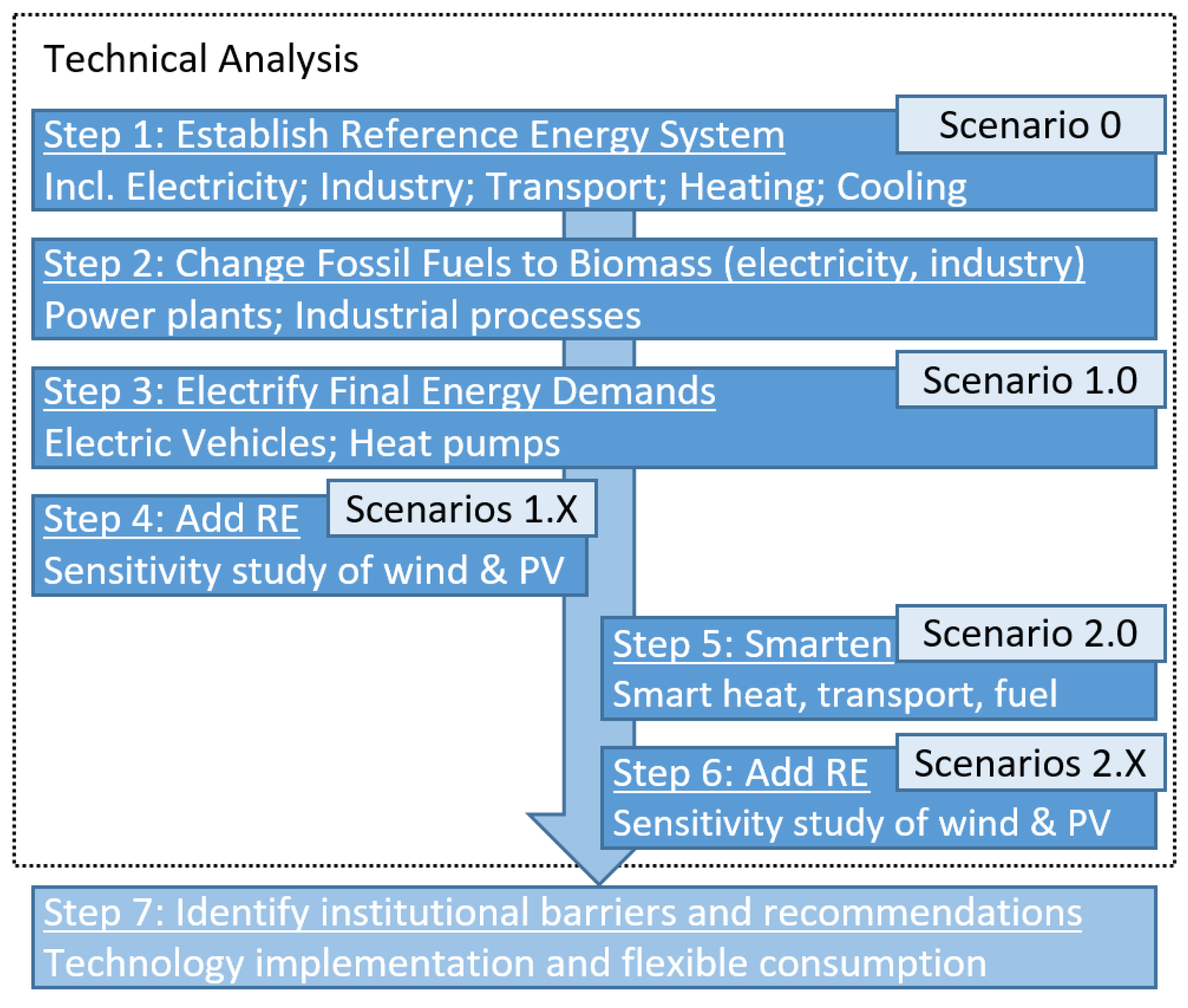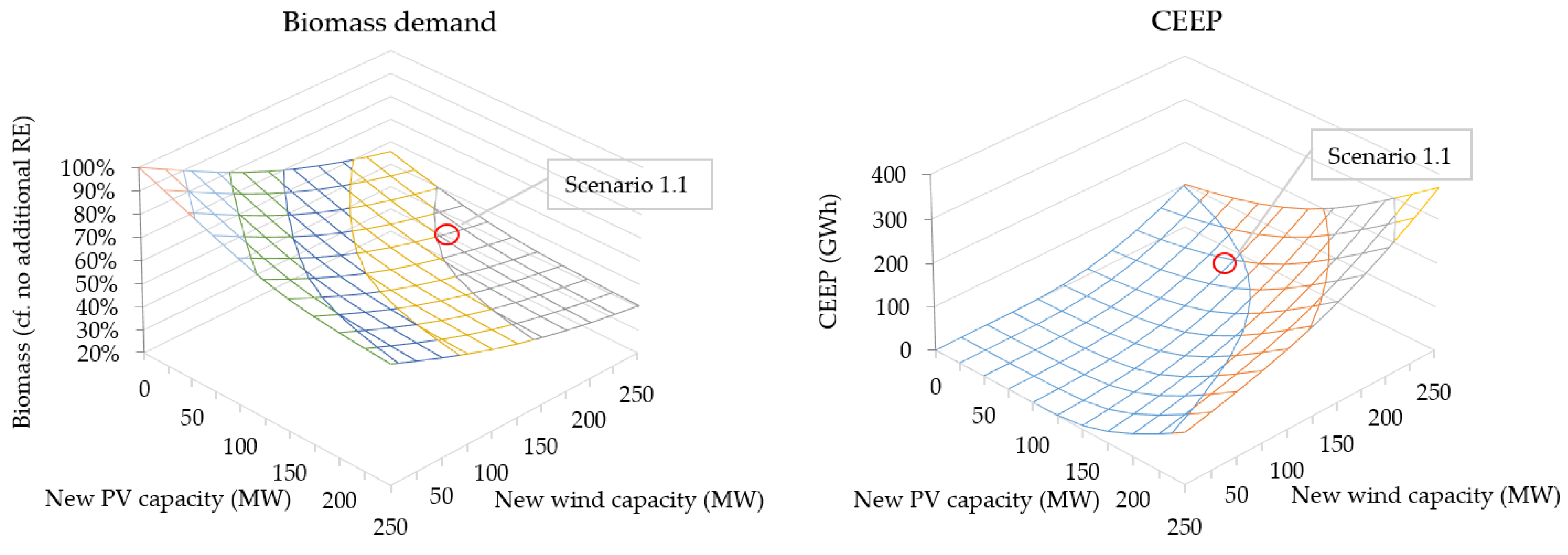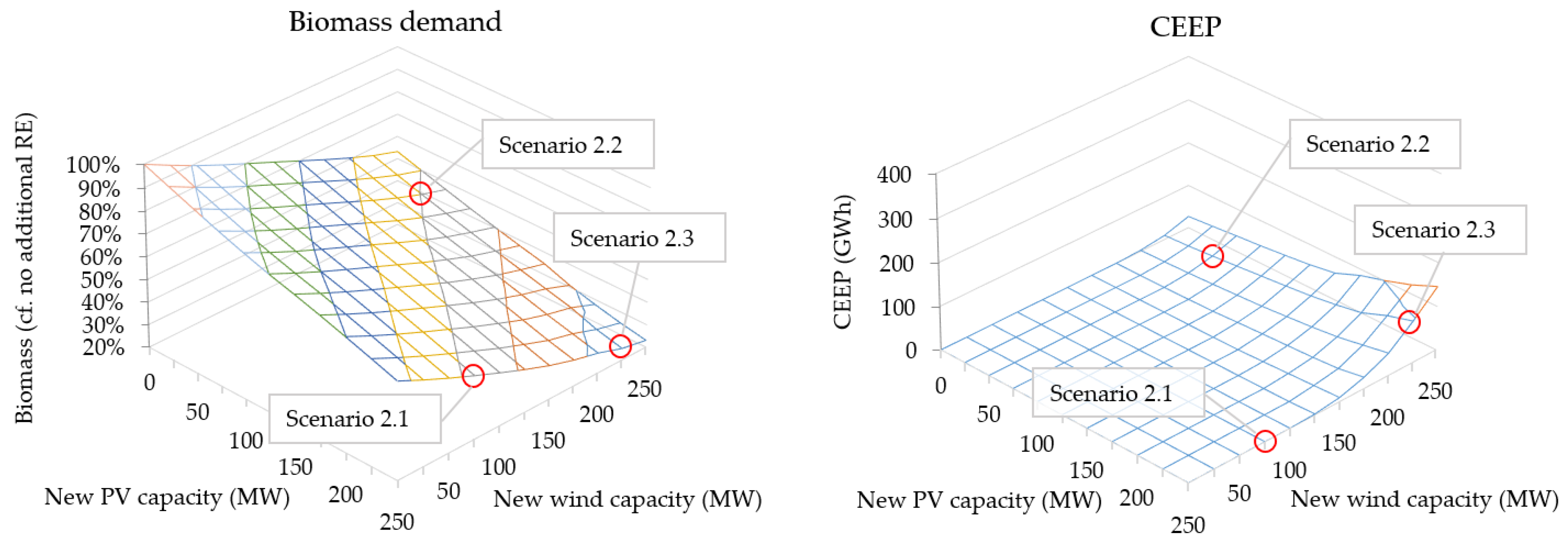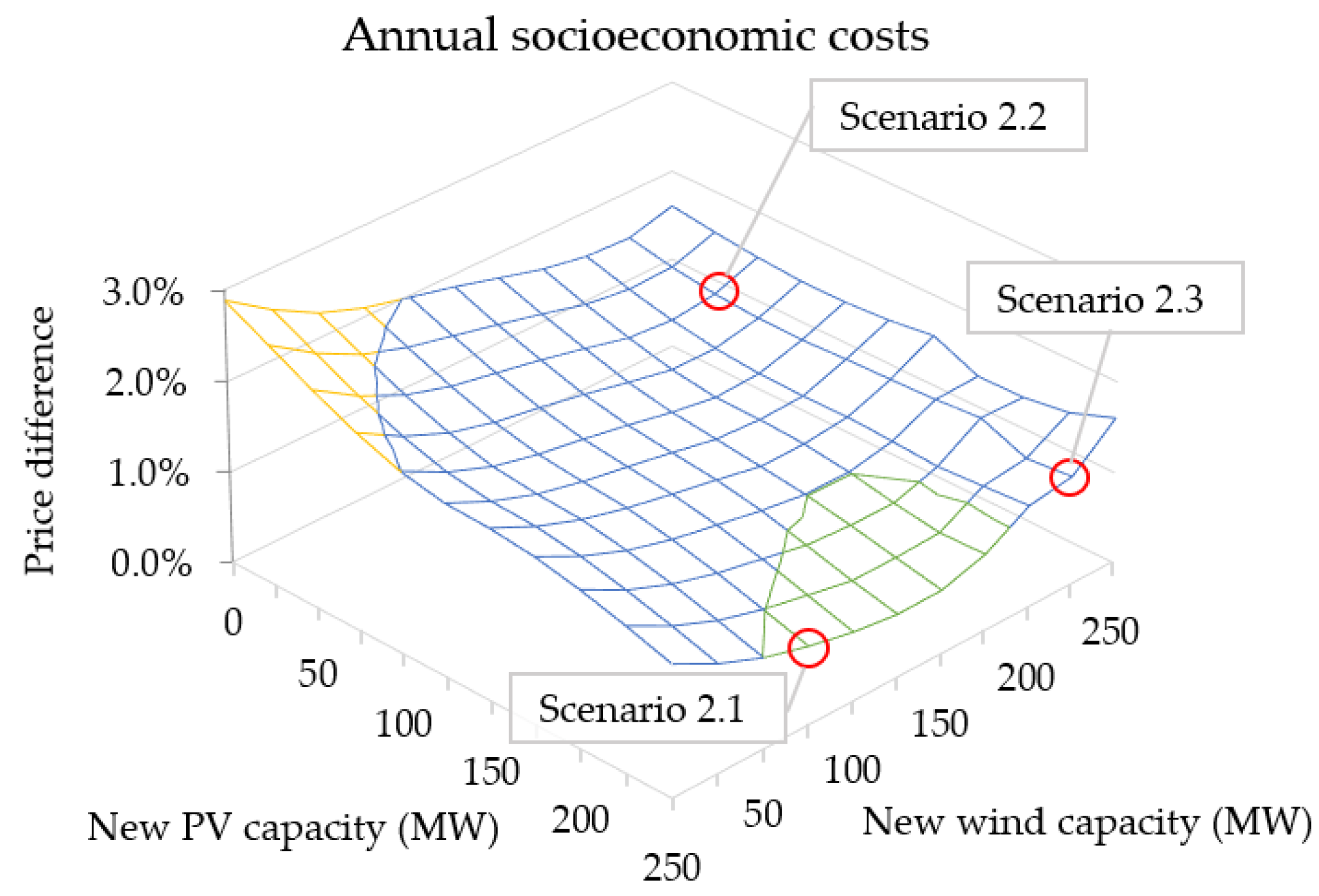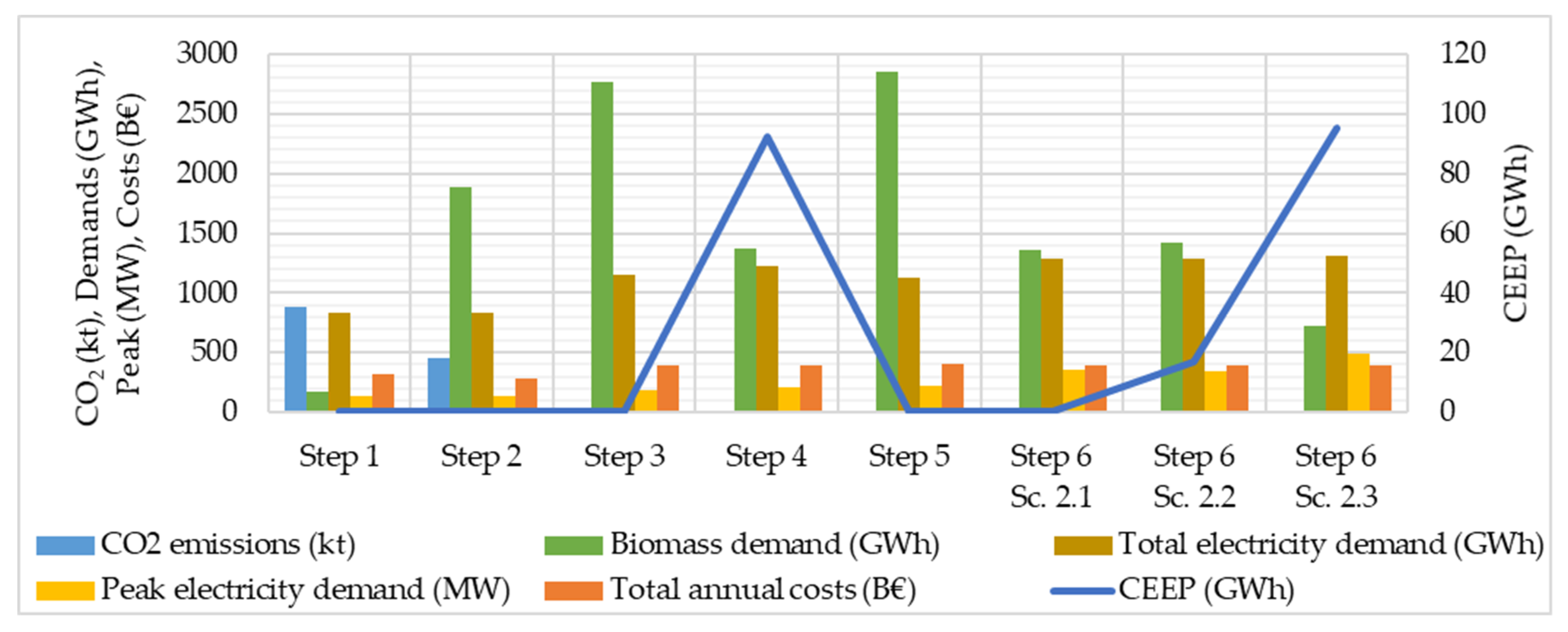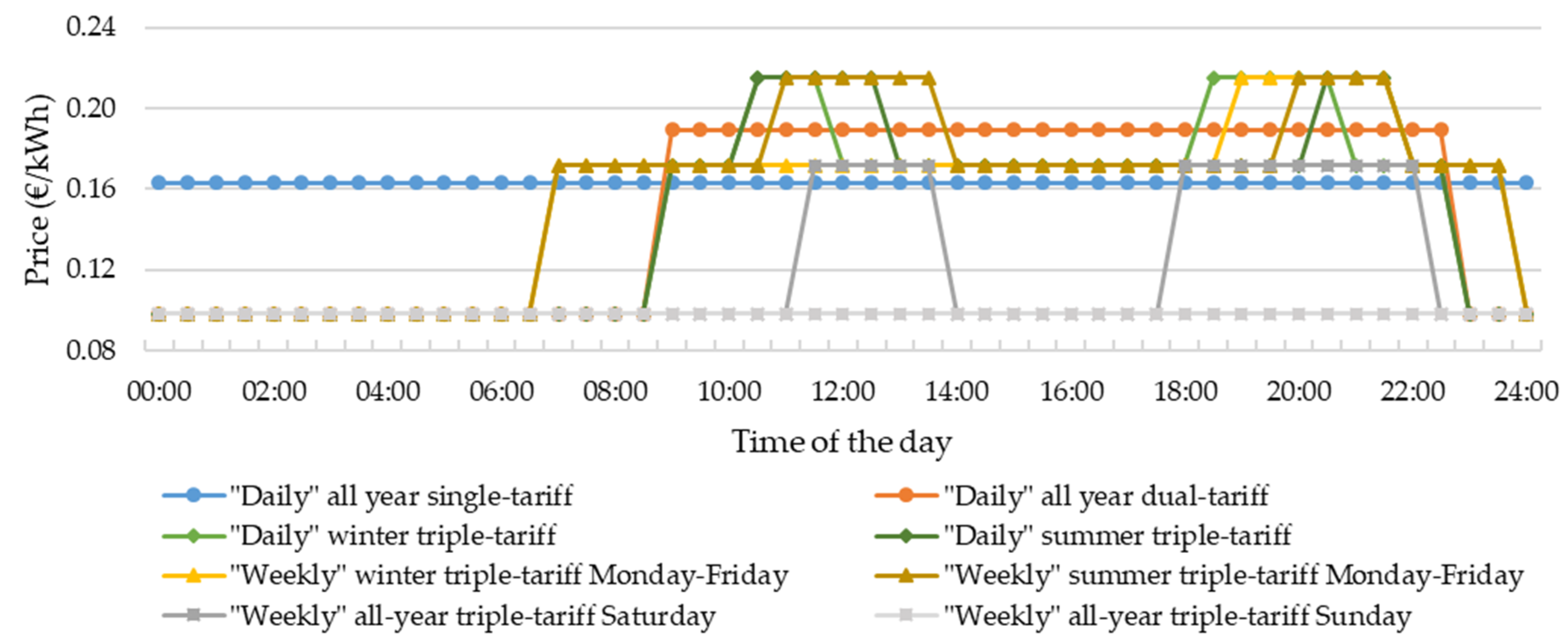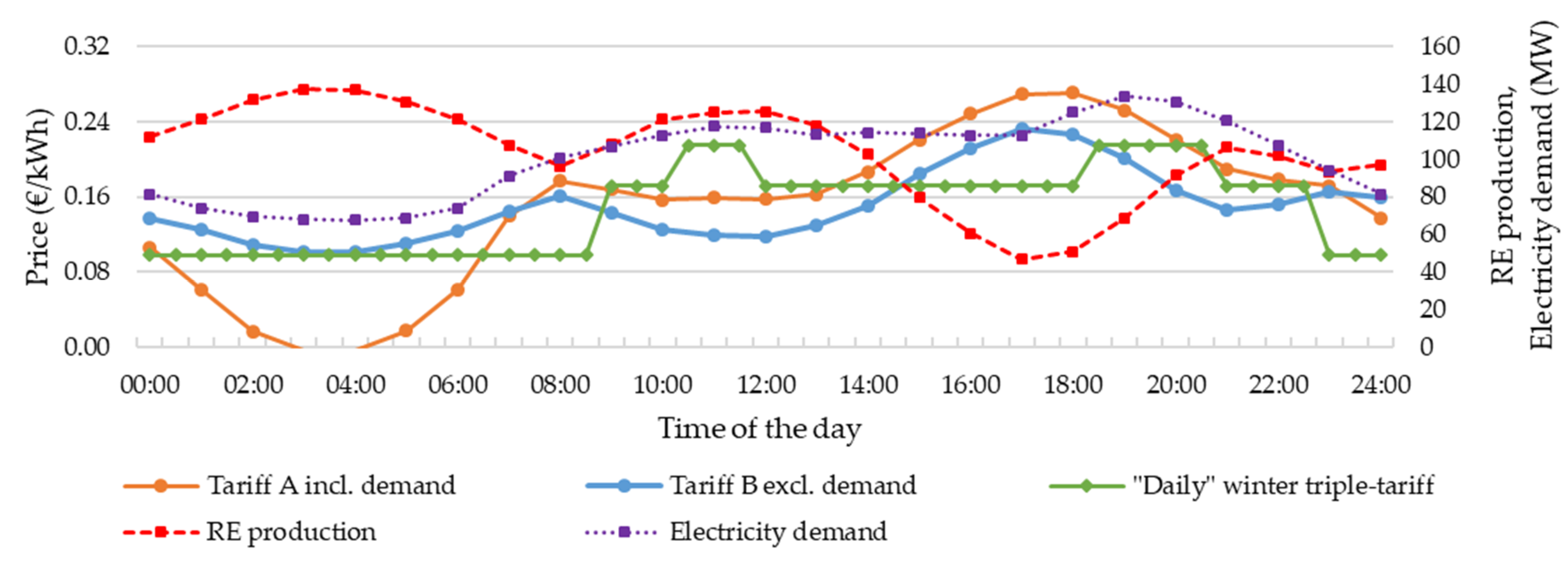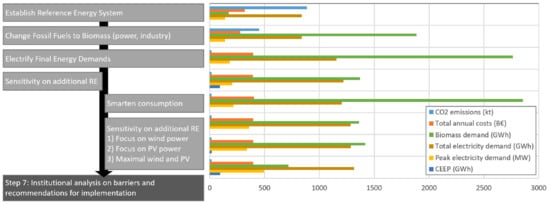1. Introduction
Energy systems, both large and small, are transitioning towards higher shares of renewable energy (RE), such as from wind or photovoltaic (PV), in response to replacing fossil-fuel technologies in the fight against climate change [
1]. A well-planned transition to 100% RE is the main objective in many places however especially islands present challenging systems but also potential lighthouses in the struggle to analyze and identify the best approach to transitioning [
2]. Not only are small and/or developing islands sensitive or even vulnerable in terms of access to energy at a reasonable cost [
3], but also the importance and difficulties of various European islands was recognized in research [
4], as well as politically in the “Valletta Declaration”, which proclaims remote European islands as favorable for innovation [
5]. Despite the differences in energy-intensity, population and geography, the common main energy objective is higher RE shares and self-sufficiency—for islands and globally.
The potential of transitioning to 100% RE has been addressed on a global level by Ram et al. [
6], as well as in a more detailed review by Hansen et al. [
7]. Both present the trends and latest studies on 100% RE systems and how it has gained attention especially over the last few years. While some of the studies reviewed in [
7] have included cross-border interaction in national energy systems, they are often made in island mode or are even focusing on geographical islands, which illustrates the role of island energy system perspectives. The increased shares of wind and PV often require balancing due to their fluctuations, such as through cross-border trade or storages. This is restricted in island systems since trade is often limited and storages not always available or feasible in island set-ups.
An extensive review related to this by Jurasz et al. [
8] states that complementarity energetic studies are needed to evaluate the feasibility of variable RE. It shows that the design of energy management strategies and the balance between storage and cost of energy analysis can be used to increase the reliability of the system. The process of RE integration in a 100% RE system at a regional level not only has to take into account historical data but also future consideration for different interested entities [
8].
Various other studies and reviews have presented high RE utilization shares specifically on islands due to their vulnerability and often heavily fossil-reliant energy systems, but also due to the high RE potential. In [
9], Kuang et al. review various islands on the way to or reaching a 100% RE share by evaluating different RE technologies and strategies for improvement. Ioannidis et al. [
10] present the vulnerability and argue for the urgent need to transition energy systems of islands globally, while Cross et al. [
11] further present potentials on islands and their importance in tests and demonstration—both including the need and possibilities of 100% RE island systems. Finally, Meza et al. present the complex transformation of a developing island with RE and storage capacity in competition with diesel for the existing generators and buses [
12].
The integration of RE from wind and PV plays an important role, as the resource is naturally occurring and does not need to be traded or imported. While RE often supplies either the electricity or the heating sector, other sectors can benefit from using the renewable electricity and heat with further cross-sector integration as a required step to enable future smart energy systems and 100% RE in an efficient way. While [
6,
9,
10,
11] discuss the vulnerability and potential of RE on islands, their focus lies in the electricity sector, which is, however, already expanding across other sectors and is therefore required to be acknowledged differently. This cross-sector energy system planning—which is also known under the smart energy system (SES) label [
13,
14]—addresses the intermittency of RE through the integration of electricity, heating and/or transport sectors to provide the best integration flexibility and maximize the impact of smart balancing technologies. This flexibility option is also referred to as multi-energy system interaction, where different energy sectors support each other, such as in [
15] where the power to heat potential is presented. The otherwise often used approach of cross-border trade is not always an option for many islands, where self-sufficiency should be targeted instead. Additionally, without smart energy planning, a high use of biomass in the power plants can be the result, as this is one of the primary storable RE sources that can be stored and used directly [
16]. However, using high amounts of biomass is seen critically under the energy-food nexus and should be limited to stay within locally sustainable levels [
17].
Originating from the combined heat and power production experience in Northern Europe, heat and electricity have already been widely researched together, as has also been done in island perspective by comparing thermal storage and electrical batteries in two different islands [
18]. Other examples of island studies using this approach have modeled isolated islands in the Azores [
19], a small connected island in Croatia [
20] or a large one in the Canary Islands [
21]. All these articles discuss the technical and socioeconomic benefits of integrating energy sectors in the transition to 100% RE systems by making use of additional balancing and storage options.
While the research and the presented barriers in this transition are often solely technical and sometimes include socioeconomic aspects, the institutional conditions also need to be aligned to support the ever-increasing complexity of energy system planning. Similarly, concerning the integration of sectors towards a SES and required changes in the technical aspects, the market also needs to align with this transformation. The change of cost structures with increasing RE shares from, e.g., wind and PV is already widely discussed for the electricity market at the national level [
22,
23]. Based on the idea of SES, markets are suggested to be aligned in a ‘smart way’ through the concept of smart energy markets, where several sectors are technically and institutionally aligned [
24]. The ongoing transition of the electricity market would benefit from considering the other sectors as their influence on each other is ever-increasing, not only technically. Existing literature, however, often includes cross-border options as well as gas infrastructure for this, which is limited in island energy systems. The design of market structures in isolated energy systems may be planned differently.
As islands present not only technically but also economically sensitive systems, this alignment of markets to support each other plays an important role in successfully transitioning to 100% RE shares. Here especially, strategic coordination of local barriers and potentials could benefit the demand as well as the supply side. Cuesta et al. [
25] argue that RE analyses in small communities can be optimized by including social parameters to make the most out of the local RE resources. Similarly, local energy markets have been proposed to include multiple decentral energy sources and bidding structures to unlock local flexibility [
26]. However, this previous research built upon the expansion of local district heating and neither in the newly recommended SES nor in an island context. These contextual considerations, however, should go hand in hand with the technical analyses.
Lund proposes to align the different technologies, social aspects and markets in the transition, especially if it includes radical change, which denotes situations that “involve change in existing organisations and institutions” [
13]. With the limitations and potentials, aiming for 100% RE supply in a smart island energy system can be considered a radical change. An approach on how to govern such radical changes is suggested by Hvelplund and Djørup [
27], who conclude that the organizational coordination of a 100% RE system requires a more active and communicative governance that coordinates the local technologies and demands. In line with this, the European Commission proposes an integrated energy market through preparedness on all levels, where the consumers are in the centre of the transition, making them an involved, stabilizing part of the market [
28]. Despite acknowledging regional possibilities, islands have been mostly overlooked in the existing research and policies, even though the alignment of technologies and markets is most fragile and eminent here and may even present solutions useful in other geographical contexts.
The trends of aiming at 100% RE supply in either the separate sectors or cross-sectorally can be considered radical in any energy system, and the required alignment of technical, socioeconomic and institutional aspects has not been made for island energy systems. An example of islands evaluating different options to reach a SES with 100% RE share is through “smart technologies” in the Horizon 2020 project SMILE (smart island energy systems) [
29], where technical and socioeconomic aspects have been introduced [
2,
30], but investigations into the institutional setup are still lacking behind. Smart technologies, such as smart charging and vehicle to grid (V2G), flexible electrofuel production or smart heating controls and storages, bring new aspects to the energy system and should be evaluated in the context of RE integration.
This article is filling the research gap for a case study, where both technical and institutional aspects are considered to integrate renewables and further reach a 100% RE share. As existing literature approaches this only to some extent, usually separate and either with a sole focus on electrification or on the whole SES, both aspects are presented in parallel in this article. Besides a comparison of technical and socioeconomic options and results through a sociotechnical analysis, the market perspective is addressed in the particular setting of an island, where local energy market barriers are identified and the potential is presented. By illustrating the required institutional setup in alliance with the technical analysis of RE and novel technologies, the paper achieves a novel angle of research.
The case study to test this novelty aims at looking at an existing energy system and its current technologies and market, and how it can be optimized to reach a 100% RE share. One of the demonstration islands from SMILE is therefore chosen, namely Madeira Island, as an exemplary isolated energy system with its own local government and in high demand of a smart and institutionally sound energy system. Hence, this research may address islands, and particularly non-interconnected ones, but also other remote and rural energy systems can benefit from it to make better use of locally produced energy.
In this paper, both technical scenarios and institutional comparisons are made to which the methodology can be found in
Section 2. The corresponding results and recommendations are presented in the technical analysis in
Section 3 and the market analysis in
Section 4, before a discussion of both is made in
Section 5.
Section 6 concludes the whole paper briefly.
3. Sociotechnical Analysis
In this section, all steps and scenarios are presented, for which the results, including the KPIs, can be found in
Section 3.3. The corresponding institutional market analysis follows in
Section 4.
As described in
Section 2.1, the Madeira Island energy system model from 2014 formed the basis for the reference scenario and was updated in Step 1 of the analysis. This included the decommissioned hydropower station, as well as newly installed hydropower and PV capacities between 2014 and 2018. Hence, 50 kW of additional PV and 30 MW of dammed hydro power capacity with 16.5 MW pump capacity were added, while an older hydro power plant of 3.5 MW was decommissioned (based on communication with EEM in January 2020). This resulted in the Reference Scenario 0 to which later scenarios were compared. This energy system had a RE share in PES of 11% and in electricity supply of 30%.
3.1. Electrified 100% RE System
Corresponding to the scenario methodology in
Section 2.1, the following Steps 2 and 3 replaced all fossil fuel with biomass or electricity. While switching to biomass in combustion processes did not entail any technical adaptions in the model and its operation, the transport and heating did. The change from petrol and diesel cars to EVs included a change of efficiency in addition to the different input. While oil-fuelled vehicles were estimated to drive 1.5 km per kWh, EVs were assumed to drive 5.9 km for the same unit of energy input (EnergyPLAN assumption). In regard to heating, all boilers still using gas, biomass and oil had efficiencies of <90%, while heat pumps had an equivalent of 300% (COP of 3.0; considered constant based on average annual value), so the overall amount of required input was reduced drastically by the end of Step 3.
With the change to biomass in power plants, the electricity sector reached a 100% renewable share, whilst the inclusion of the remaining sectors of industry, transport and heat also led to a 100% share in the PES (cf. Scenario 1.0,
Table 1). The sustainable share of electricity, however, was the critical voice for when biomass was considered renewable yet not completely sustainable. As it is unknown if this amount of biomass is currently fully sustainable to harvest and combust, this was a caution factor. While the amount of biomass increased 16-fold, the CO
2 (from fossil and waste combustion) reduced by 98% from the reference scenario. Electricity demands increased by 38% and 29% for total and peak demand, respectively.
The next Step 4 is illustrated in
Figure 3, where the electrified energy system was analyzed in a sensitivity study with various additional RE capacities. The results were reconciled with the target criteria, where biomass was reduced by at least 50% and CEEP was kept to <100 GWh, which resulted in only one option: Scenario 1.1.
By addressing these criteria, Step 4 resulted in the additional capacity of 100 MW PV and 200 MW wind but also increased the sustainable share of electricity to 77.6%. Hence, in technical terms, the energy system of Madeira Island was now 100% renewable and supplied by 60% RE through wind, PV, and the other previously installed RE, while the remaining 40% was supplied by biomass combustion. As can be further noted from
Figure 3, the biomass consumption reduction stagnated shortly after the 50% reduction target (even with 250 MW PV and wind each, it reached 59% biomass reduction). Furthermore, only 9 out of the 121 possible scenarios resulted in 0 CEEP, but here the biomass reduction potential was below 20%. The details of Steps 1–4 and the Scenarios 1.X can be found in
Table 1 next to the results from Steps 5 and 6 and its corresponding scenarios 2.X, which are explained in the following.
3.2. Smart 100% RE System
Firstly, the smarter heat entails an intensification of thermal solar collectors—double the capacity, as well as TES—to supply 100% of households and for a maximum period of 10 days, which optimizes the operation of the heat pumps. Secondly, the smartening of the transport demand including V2G requires the addition of the right grid-to-battery capacity and vice versa. The maximum share of cars charged during peak and the share of grid-connected cars was defined as 50%, and total battery storage capacity was 5 GWh. Thirdly, the smart fuel addition entailed the introduction of electrofuel through the example of an electrolyzer to produce hydrogen and 20% of the transport demand to be covered with it, as well as the option of hydrogen storage of 100 MWh. All three steps increased the electricity demand but reduced the CEEP. In EnergyPLAN, the electricity demands of EVs and the electrolyzer were flexibly modeled according to the RE production.
Step 5 resulted in Scenario 2.0, which is similar to Scenario 1.0 but slightly more expensive due to its complexity. The following sensitivity study in Step 6 therefore was required to show its full potential. Step 6 addresses the same target points as Step 4 to increase sustainability shares through reduced biomass amounts, costs and CEEP. In contrast to Step 4, where only one scenario fulfills the targets, the SES approach offered 41 possible options within the same criteria. The following proposed scenarios therefore could further address potential limitations in available land and visual impacts if required. Scenarios 2.1 and 2.2 thus demonstrated mainly PV or wind, respectively, while Scenario 2.3 did not consider any of these limitations. The results of this sensitivity study can be found in
Figure 4, which shows that biomass reduction potential spanned longer than in the electrification scenario (1.X) with up to 77% biomass reduction at full additional capacities of 250 MW each. Furthermore, CEEP can be avoided in 72 out of 121 possible combinations and remained below 100 GWh in all but three options.
The three proposals out of the 41 options of PV–wind combinations can be pointed out in
Figure 4. All proposals show a different extreme in terms of RE capacity, as well as consider potential limitations, so either one could be recommended to the island of Madeira depending on local requirements and wishes.
The first SES scenario included the maximum PV capacity within the sensitivity study and required a minimum wind capacity of 75 MW to reach the biomass reduction of >50%, which was not possible with 50 MW wind capacity (48%). It is one out of five scenarios that fulfilled the criterion and remained at 0 GWh CEEP, which was not possible with the electrified energy system scenarios. With the increasing opposition to wind turbines and potential available space on rooftops, among other challenges, this “PV Scenario 2.1” may be the preferred option to the local community. Despite only minor differences in the total annual costs, this scenario also presents the cheapest solution under the smart system approach.
The second SES scenario presents a wind-favored option, at almost maximum wind capacity and minimum PV capacity within the target criteria range. With 225 MW additional wind and 50 MW PV capacity, the CEEP was kept at 17 GWh annually, which corresponded to 2% of the electricity production. As can be seen in
Table 1, the peak demand was the lowest in this scenario; however, this resulted from the peak supply delivered by the wind turbines and the smart charging and hydrogen production accordingly. This overall lowest total capacity further entailed the overall lowest number of new installations, since capacities of single wind turbines was much higher than PV systems, therefore this more centralized concentration of RE could be preferred.
The third proposed scenario, Scenario 2.3, aimed at the highest biomass reduction while staying within the CEEP limitations, and even within the cost requirements, as it is even cheaper than Scenario 2.2. With the CEEP value of 95.5 GWh, which represents 6% of the production, a biomass reduction of 75% could be achieved, resulting in a 9% share of biomass for the electricity supply. For this, 250 MW PV and 225 MW wind capacity was installed, which, however, ignores the potential space and visual limitations that might exist. It presents, however, an option if biomass is to be limited. This way, Scenario 2.3 was the most sustainable scenario with a sustainability share of 99%. For all scenarios with large PV and/or wind capacity, environmental aspects in their production could be considered.
Alternatively, if none of the above presented scenarios appears optimal after all, a compromise or combination of their aspects could be considered. For example, if suitable land for wind turbines are limited but should still be included, other scenarios could be further evaluated with
Figure 4 and
Figure 5. Regarding biomass reduction, 15 combinations require <1000 GWh biomass; and regarding CEEP increase, 72 combinations are at <0.1 GWh CEEP and another 27 within 0.1–25 GWh CEEP. Finally, the target criteria of cost limitation are presented in
Figure 5, where the socioeconomic cost development of the scenario is illustrated in comparison to Scenario 1.1. In contrast to the biomass consumption and CEEP, it did not develop linearly but shows the optimal scenarios at PV capacities above 175 MW and wind capacities between 50 and 175 MW. Regarding annual socioeconomic costs, Scenario 2.1 would be the most secure in this regard, but further 11 other combinations would be as well.
3.3. Comparison
When comparing the technical analyses of transitioning to 100% RE on Madeira Island, the SES approach presented more options and thereby more benefits than the simplified electrification approach, addressing all KPIs. This was clarified with an overview in
Table 1 and illustrated in
Figure 6. Both alternatives achieved CO
2 reductions and higher shares of renewable and sustainable sources. Compared to the reference case, Scenario 1.1 reduced the CO
2 emission by 98% but increased the biomass consumption by 690%, the annual and peak electricity by 45% and 47%, respectively, and the annual costs by 23%. Scenarios 2.X achieved the same CO
2 reductions and similar changes compared to the reference. The remaining CO
2 emissions were related to the waste incineration.
When comparing 2.X with 1.1, however, biomass could be reduced by up to 52%, CEEP by 100% while costs increased by 0.7–2.9%. Overall, the 2.X scenarios show more possibilities for potential local restrictions. While Scenario 1.1 could achieve the biomass, CEEP (7% of total electricity production) and cost targets only in one PV-wind combination, the Scenarios 2.X present 41 combinations. If one specific target was in focus, e.g., CEEP limitations, the sensitivity study of Scenarios 2.X presents 72 combinations where CEEP can be avoided completely. This concerns only 9 out of the total 121 options for the 1.X-scenarios.
While 100% RE share of PES was reached after Step 2, the sustainable share, where biomass was used as little as possible, reached 70–99%. When taking into account the sustainability available biomass on Madeira Island, this could be elaborated. The share of RE of electricity reached values above 100% if the production exceeded the demand.
Complementary to
Table 1,
Figure 6 illustrates selected KPIs. While CO
2 emissions dropped drastically within the first two steps, biomass consumption increased until RE was added. Still, electricity demands were increasing with each step, similarly to the costs. While electricity demands increased by 57–350%, the costs increased by only 24.5% compared to Step 1. When including the additional CEEP values, the dependency between all KPIs is shown.
The basic electric approach is nonetheless an essential part of the transition to 100% RE share, while the additional smartening of the energy system can be understood as a potential, yet beneficial, second step. According to this, the market analysis addresses both approaches in the following section as a supplement and preliminary discussion for the implementation of proposed technical scenarios.
4. Market Analysis
Based on the above sociotechnical analysis of the two approaches to 100% RE share on Madeira Island, the institutional barriers and market requirements are addressed in the following. It becomes clear that the SES approach has more benefits in technical and sustainable terms and allows for several combinations of wind and PV capacities while being in line with the scenario targets. However, Scenario 1.1 competes with Scenarios 2.X in socioeconomic aspects and is otherwise an essential baseline for the potential uptake of smartening afterwards. The following institutional analysis therefore contributes to the comparison of the two approaches and sees Scenario 1.X as a basic first step and Scenarios 2.X as a necessary second step in the market for an optimal transition to 100% RE.
The main barriers that are not apparent in the technical scenarios in EnergyPLAN, however fundamental, are the implementation of the modeled scenarios with their corresponding technical requirements. Specifically, the island-wide change to electric heating and transport can be connected to radical changes in people’s homes, public buildings and infrastructure. Additionally, the SES approach includes flexibility options that require the production of hydrogen, heat from heat pumps and the V2G in accordance to the RE power production. While this is modeled optimally in EnergyPLAN, incentives, regulations and/or market redesign are required for implementation.
The following therefore addresses this issue on the consumer side as the key technologies can be found there and also to increase consumer participation in the energy planning. As introduced in
Section 1, the European Commission proposes an integrated energy market, where the consumers are put at the centre of this transition. As this paper focuses on the opportunities of EVs and heat pumps,
Section 3 shows how the consumer is required to help in this part of the transition. This may be an important aspect in order to address the implementation and flexibility issue, if planned accordingly in this institutional setup. Furthermore, the encouragement and engagement of the consumers allows not only for wider acceptance of required technologies but also results in benefits for the grid operator if their interests align through increased grid flexibility.
4.1. Barriers
As explained in
Section 2.2, the technical analysis influenced the institutional one as the complexity in the technologies was also reflected in the market complexity. With more technologies on the supply, conversion and demand sides, as well as in balancing in the SES approach and improving cross-sector integration, the supporting institutional framework also needs to be addressed. Here, the decentralization in the energy sector requires a different focus to involve consumers more.
In the past—in contrary to the two proposed approaches—energy systems were dealt with separately and markets were centralized and based on fossil infrastructure, hence balancing, integration or alignment was not as complex. With the increase of fluctuating RE, this stability is affected, requiring technical and economic adjustments, as energy production and market complexity increases. When aiming at 100% RE systems, hence, the institutions and markets as we know them need to move away from the paradigm of fossil fuel being at the centre of the energy market. By coordinating the integrated market prospected by the EU, the consumers are put at the centre of the energy market and smart technologies would be allowed to become competitive.
The introduction of the smart energy markets concept [
24] shows the direction these RE-based systems can have, although they must be adjusted to the limitations of islands and be more focused on the self-sufficiency of energy systems with limited resources. As transmission lines might not be available and imports can be uneconomical, the local integration through electrification of additional SES aspects is important. However, the markets of islands are usually set up in a similar manner as the national market, which does not have the same limitations. This leads to the increased necessity on islands of, on the one hand, decentralized and local utilization of RE for electricity, heating and transport demands and, on the other hand, flexible demand and balancing. Both the electrification as well as the SES approach can be evaluated accordingly.
In Madeira Island, the incentives to increase both the local utilization and the flexible demand are limited. While incentives exist for the purchase of EVs at national [
44] and regional [
45] levels, the number of EVs is still limited, showing that the incentive might not attract enough people. Barros et al. [
42] further show that the average EV user on the island has an income above average, and that the general conception of EVs is still hesitant—either regarding battery lifetime, charging time or suitability for the island orography. Despite the current option of free public charging for EVs, their share on the island is less than 1%.
Incentives for purchasing heat pumps, TES or even electrolyzers and hydrogen vehicles are not available at all as of writing. If the consumers are to increase their use of these technologies, it is necessary to make them understand their benefits, addressing the hesitance and criticism by working on the acceptance and understanding from the end-user perspective. While this is a barrier, it can also be a potential to explore through the local consumer-involved energy market.
On the other hand, incentives for flexible consumption are in theory available for all sectors, yet with a limited reach so far. The local transmission system operator (TSO)/distribution system operator (DSO; EEM) together with the national energy services regulation entity (ERSE) introduced time-of-use tariffs to address the local issue of high electricity demand peaks during the hours 9:00–13:00 and 18:00–22:00. The result was an optional choice between three main tariffs, which only change according to season (summer and winter season) and potentially weekdays (Monday–Friday, Saturday and Sunday), see
Figure 7. According to EEM, the idea is to incentivize consumers to use electricity during the night, as this is when curtailment—or in the technical analysis CEEP—most likely occurs [
43].
Despite the free charging options, EV owners preferred to charge at home, either due to comfort or time constrains, but often excluding the tariffs in the considerations evaluated in [
42]. On the contrary, Hashmi et al. [
43] suggest that the daily tariffs are preferred without the cheaper weekend prices. While this limits the peak shaving, the local peak power contract (PPC) also has a restricting impact on the flexibility of consumption. The PPC is the maximum demand that consumers can draw from the grid and results in local power shutdowns if exceeded. Furthermore, single and dual tariffs are still the preferred option, not evidencing the benefit of EV charging at times when the electricity prices are cheaper and despite being better for the DSO/TSO.
Although incentives for more dynamic consumption are available, the current tariffs do not consider the actual sustainable share in the electricity mix. This price flexibility, yet inflexibility, has the same impact on encouraging the use of sustainable electricity in all sectors, as it does not seem to make a difference in price where the electricity is coming from. Hence, there is no difference if it is coming from a combustion plant—even though it might use biomass, it might not be sustainable due to the limited resource—or from the unlimited and sustainable sources wind or sun. Even though hydrogen is not yet much developed in Madeira Island, it plays an important role in illustrating the need for flexible production of an alternative fuel. However, examples from other islands show that there is currently no incentive to run the electrolyzer during windy/sunny times instead of during times of imported/combustion-based power, leading to the difficulty of producing green hydrogen, as is the case in the Orkney archipelago [
46]. Overall, the use of best technologies at optimal times requires new approaches, which is addressed in the following.
4.2. Recommendations
The radical changes proposed and the barriers identified in the previous sections form Phase 1 and Phase 2 of the institutional analysis. In the following Phase 3, concrete changes to the market structure are suggested accordingly with a focus on end-users and energy markets though including basic aspects of the technology markets, as strategic energy planning suggests.
As evidenced above, the consumer can be economically incentivized to use electricity at certain hours—in either the electrified scenario through heat pumps and EV charging or in the smart energy scenario through additional technologies. This can be done when it is also beneficial for the grid operator, resulting in a flexible and dynamic energy market, where the fluctuating RE production is in the centre. To allow for a dynamic market, the first step is the uptake of suitable technologies on the demand side. The number of EVs, heat pumps and potential electrofuel technologies require incentives that convince consumers to invest. This can be achieved by increased support and/or clarification of the long-term benefits and by considering all income groups, addressing the social barriers mentioned. The recently introduced incentives on both the local and national level present such benefits and should be secured and potentially elaborated in the future. This represents a prerequisite to implementing the smart scenarios and goes hand in hand with suitable financial incentives for electricity consumption, aiming at the second step to market dynamics. In line with this, [
47] shows the importance of incentives at the right stage as they were evaluated to be better placed at operation than at purchasing state of EVs.
Semi-flexible electricity prices have been introduced to regulate the demand and encourage consumption outside peak hours through optional tariffs, but this is not yet widely done and must be adapted to a 100% RE system and to the sensitive energy systems of islands. However, the currently used time-of-use tariffs are not suitable for high RE scenarios and more flexible tariffs are suggested to overcome the existing barriers by including equality and transparency for the consumers [
48]. In comparison with
Figure 7,
Figure 8 indicates a potential price mechanism according to RE production, with the option to take the electricity demand (projection) into account. Similar average daily prices of 0.15 €/kWh are compared to the current tariffs, but with more extreme peaks, incentivizing dynamic consumption. This is shown in an example for 7th January, where consumption is encouraged during the windy night (and low demand), instead of the early evening, where ceasing PV and wind production (and high demand) increase the price between 15:00 and 20:00 drastically (cf. triple-tariff).
This recommendation would make smart technologies competitive to the current use of fossil fuels. By taking into account the sustainability of the local RE production, the transmission and their costs, the price signals must be adjusted accordingly. With yet a small number of EVs but already a demand for peak shifting now, the need for scheduling is already pointed out, which will increase with additional technologies in the energy system and which will be possible with elaborating on the dynamic price mechanism proposal.
Hence, the current tariffs for end-users on Madeira Island (cf.
Figure 7) can be the starting point but are recommended to become mandatory and more dynamic according to the sustainable electricity from wind and PV. Furthermore, the proximity of the consumer to the production side is to be taken into account to reflect the true transmission/distribution cost. As demonstrated in [
49], proximity is a positive contribution to consumer behavior, and in [
50], resulting lower prices for local consumers are argued to increase acceptance. Hence, the local TSO/DSO is to control and schedule price signals according to the technical capabilities of the overall energy system—similar to what is already done—but including further market perspectives by considering the consumer as a controllable load that requires incentives. This can be applied to EVs, heat pumps and other demands that allow flexible operation either through smart charging, TES or hydrogen storage capacity resulting from the first step. A smartly controlled or scheduled approach would also address the PPC problem and weather forecasts could also be considered in this recommendation. With increased digitalization, this and more can become an important attribute to future energy markets [
51,
52].
Similarly, the Madeira-specific free EV charging will not be possible for long. However, a low price for charging EVs can be negotiable according to the conditions by limiting it to hours of high sustainable energy shares. As [
42] shows, some EV owners act according to price incentives when charging and they are suitable flexible consumers. This entails an expansion of charging options, not only public ones but also in business areas and smart charging support. While some solutions can be managed centrally, others may only be possible at private facilities, hence different tariff options can be considered respectively. When this is in place, a smart approach to V2G must follow to bring the full potential to the energy system by providing balance through short-term storage. This requires another economic incentive for the consumers at the household level, as their EV batteries’ life cycle would be affected and the time to charge the EV battery prolonged. This is addressing the barriers of hesitance mentioned in
Section 4.1 and is supported in [
53], where remuneration is further elaborated. Thus, a selling price higher than the buying price is recommended, signaling the value to the market. If EV owners were not to be allowed to make a profit, this balance option would be limited to the DSO/TSO, showing an example of the importance of consumer involvement.
Though outside the scope of this paper, the limited uptake of RE capacity at the household level, where consumers become prosumers, would be further addressed with these recommendations. While there is now an injection limit from microproducers, such as PV owners, to the grid, the additional control of consumption through location-based prices could enable an easing of injection limits. This could further lead to household PV capacity increase, which may be required besides large-scale PV parks for the energy system in this paper, especially Scenario 2.1.
An overview of the two approaches, their barriers and potentials as well as recommendations can be seen in
Table 2. As visible, the number of potentials is higher for the multi-energy SES approach, yet the market requirements address both approaches as the electrification still forms a first step towards the smart approach. Further discussion and recommended research can be found in the following section.
5. Discussion
This paper fills the previously identified research gap by showing the needs and possibilities of Madeira Island to reach a 100% RE share from both technical and institutional perspectives. To this end, two approaches are developed and compared to each other to show their strengths and weaknesses, and how they can be supported in the right way.
The importance of sector integration in a multi-energy system is presented in either approach as electricity demands can be found in the heating and transport sectors already and shows to be the way forward for the most dynamic and smart energy system as well, especially for islands. The paper shows how smart technologies and the inclusion of other energy carriers than electricity can be beneficial by providing flexibility. By using EnergyPLAN, the technical model simulates the optimal balance between the sectors and technologies. While technical analyses often do not consider the required institutional support, by adding a market analysis, the implementation potential of the technical scenarios is addressed in this work as a supplementary requirement for a full transition to high RE shares. Through consideration of the transition as being radical and analyzing market barriers accordingly, the importance of consumer involvement and demand response becomes evident. Therefore, the introduction of social parameters and local energy markets also proves to be important in islands and the presented transition.
With a three-phase institutional approach after the technical step-by-step modeling, the consumers are recommended to be more involved in the market, enabling benefits for both supply and demand sides. This entails the recommendation of institutional support, as the potential of flexible demand response can effectively be realized with dynamic pricing. This supports the implementation of the optimally modeled technical scenarios. With Madeira being a special case since its own local authority is in a position to develop this, it also shows how local power and regulation can be the key to local energy systems transitioning to 100% RE. On the contrary, if local entities are excluded, it can become a bottleneck for local energy market development.
The simplified electrification approach competes with the smart approach in socioeconomic terms by being 0.7–1.6% cheaper but at higher biomass consumption and/or CEEP. Hence, the smart technologies might be more costly, yet only marginally, while allowing for less biomass and/or CEEP. The overall increased annual costs (30% more than the reference scenario) can be attributed to large investments, such as EVs, but should also be considered in the long term, when imports are reduced and the local economy benefits from it. The benefits in reduced biomass and CEEP may require investment and exploration of electrofuels, additional storages and technologies, yet it competes with the mere electrification with various RE options and limiting its capacity. The resulting optimized utilization of fluctuating RE production allows for higher peaks, yet better acceptability, flexibility and control, both from technical and consumer perspectives.
However, for the discussion and elaboration of analysis and results, further considerations and research is recommended, for example, a discourse on the technologies to implement and the biomass resource locally available. Outside this paper’s scope and not further addressed, the underlying capacity required for the scenarios entail investment, installation and maintenance. While this is reflected in the total annual cost, the implementation can be further studied. Similarly, the knowledge and resources might be locally limited, influencing the proposed scenarios. Hence, if biomass is not suitable or limited for the power production supplementing the fluctuating production from wind, PV and hydro plants, a different combination of technologies or resources is required. As hydrogen is used as an example of flexible demand with various purposes, other electrofuels or synthetic products could also be considered. Furthermore, the sustainability of biomass can be elaborated as well as its transport across the islands versus decentralized exploration close to its origin.
The technical modeling is done on an hourly basis and thereby includes seasonal and daily variations. It could, however, be improved by using an intra-hour analysis, which might be especially relevant for a sensitive island system. Additional detailed market analysis could further advance this aspect of the paper. The proposed incentives for investments in EVs or heat pumps require further examination if every consumer would require them, but some limitations might be in order. With different options for smartening the EV sector, further study is recommended of both centrally operated and private options, such as the implementation of V2G in order to increase the involvement of electricity consumers in the Madeira microgrid market. The final implementation of the tariffs would entail additional research of details not only for the electricity end-users tariffs but also for the integration of V2G. EV batteries degradation from excess of charging/discharging cycles has to be taken into account, as well as minimum EV battery range for users’ daily commutes and EV users’ disposal to have their vehicle available for the grid operations, specifically in hours with more RE.
Global market developments are to be taken into consideration, since the socioeconomic part of the analysis gives an impression but could be improved if prices for EVs or other investments drop. This also points out that the resulting total annual costs are very compatible with the reference since high investment costs are also included. Despite focusing on the consumers’ side in this transition, energy efficiency measures are not included but could benefit it in various ways and be considered more in future research. Lastly, additional energy infrastructure, such as gas or district heating/cooling, could put further significance on a holistic energy market, making use of the various opportunities presented; and a study of other islands’ consequential policies would be the final step. Overall, the complexity of energy system planning for low-carbon energy transitions and high RE shares is evident and the need for alignment of technical and institutional analyses presented through the perspective of islands but for the benefits of all.
6. Conclusions
The research gap is addressed by combining not only two different energy system planning approaches but also technical and institutional aspects of transitioning the energy system for the case of Madeira Island. The step-by-step approach to a 100% RE and highly sustainable system is modeled with EnergyPLAN and addresses market barriers and potentials in the complementary institutional analysis. The impacts of the different steps in the transition are shown and the benefits of a smart energy system pointed out. The particular settings on the island are thereby included and the limitations and sensitivity of the energy system properly addressed.
It is shown that island energy systems require a more complex energy system and smart technologies to cope with the lack of cross-border trading, where local conditions are considered and self-sufficiency improved. Without the smart energy system approach, biomass consumption and curtailment are to be expected. This, however, requires support mechanisms that take into account the fluctuations and local restrictions of RE, where the role of the consumer becomes more important. In the case of Madeira Island with its own government, better local adaption can be expected as specific tariffs and incentives already exist specifically supporting the local situation.
The general need for better alignment with market aspects is pointed out for the implementation of the technical scenarios through recommendations resulting from a market analysis. It is illustrated how important the consumer is for capacity investment and flexible demand, which can only be reached with incentives for both installation as well as use of smart technologies. Specifically, dynamic electricity prices are recommended that align with the sustainable share of electricity and the local possibilities and restrictions.
The presented research can be replicated in other energy systems and become most relevant for those with sensitive or limited infrastructure but can also be relevant for those systems that aim for higher self-sufficiency and more independence even when being well-connected. With a well-planned transition to 100% RE, as is demonstrated with this paper, the replacement of fossil fuels and the fight against climate change can be achieved.
